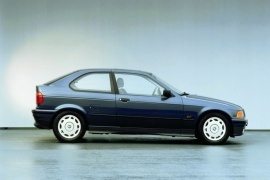
BMW 3 Series Compact
Generations Timeline, Specs and Pictures

To attract more customers on its side, BMW introduced the 3-Series compact in 1993.
The second and last generation was introduced in 2000. It didn’t work too well.
While the first generation of the 3-Series Compact was based on the E30 platform, the second generation was based on the E46 platform, which was a way better technical solution. The idea was to build a cheaper BMW, so the young customers will be attracted by the brand and then stick to it. The same thing did Mercedes-Benz with the C-Class Sport Coupe in 2001. And they failed as well.
For the second generation, BMW chose a different front fascia than the regular E46 3-Series. The rounded headlights in the middle and the wider one on the outer side, looked like they were separated, but they were in the same headlight unit. The 3-door bodywork featured the same front doors as the 3-Series Coupe. The rear quarter panels were different since the car was shorter. Instead of a windscreen in the back and a separate trunk-lid, the Compact version featured a tailgate.
Inside, the car was similar to the 3-Series E46 coupe, with the same interior room. Despite the long, 2.75 m (107.3”) wheelbase, since the engine was placed longitudinal, the front seats were pushed rearward. The dashboard was the same as the one found in the regular E46.
For the engine side, the 3-Series Compact was available with a choice of gasoline, and diesel engines ranged between 1.6-liter and 2.5-liter. A 2.0-liter diesel unit also was available. The biggest flaw of the car was the design and the light rear end, which tend the car to oversteer too often.

Before 1994, the last time when BMW offered a hatchback was between 1971 and 1972 with the Touring version of the 1600 series.
And it was not a success. But for the 1994 model, it was a different story.
In 1994 there was no premium hatchback on the market, but the hatchbacks market share in the compact segment was big. So, BMW tried the market with a car that was based upon two different 3-Series models on a 3-door hatchback bodywork.
The first generation of the 3-Series compact was launched in 1994 to get the premium customers from the hatchback segment. The front of the car was identical to the BMW 3-series from the third generation (E36). But from there on, it was a mix of new and old parts. The rear suspension was taken from the second 3-Series generation (the E30). The doors were different than the rest of the E36 range, even though they looked the same. The rear windows were hinged in the front so they could open a little. The tailgate and the rear end were different than any other BMW vehicle of those days.
The interior featured a dashboard inspired by the E30 and with some parts taken from that generation. The front seats were from the E36 coupe and the rear seats could have been folded in a split 60/40 manner.
Under the bodywork, there was an E36 front suspension and an E30 rear suspension. It featured only fuel-injected engines, with displacements that varied from a small, 1.6-liter unit to the top-of-the-range 2.5-liter inline-six unit. It was available with a standard 5-speed manual or a 4-speed automatic.























































